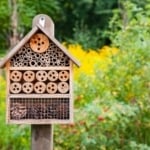How To Remove Spider Crickets Effectively
These critters may try to make their way into your home this fall. Here's how to keep these pests out without harsh chemicals.

Are you finding spider crickets (camel crickets) in your basement, crawl space, or garage? Learn how to remove these creepy crawlers effectively with our simple tips.
What Are Spider Crickets (Camel Crickets)?
Often known as “spider crickets” (because they look like spiders) these household pests are also called camel crickets, cave crickets, sprickets, criders (in the South), or cave weta (in New Zealand). They love damp, dark places and eat almost anything.
What Do They Look Like?
Spider crickets are most commonly mistaken for wolf spiders because they are similar in size and coloration. But if you look closer, you’ll see long antennae, and only six legs, including two large hind legs that are much longer than the other four—just like common crickets.

Unlike other crickets, they are wingless, and their bodies have almost a humpbacked shape (hence the name camel cricket). And they can get pretty big, too—up to two inches in length! Strangely, many people also say spider crickets resemble shrimp.
Don’t look too closely, though! Spider crickets tend to jump directly at things that startle them, which means one might leap at you if you scare it! They aren’t attacking you; it’s a defense mechanism for frightening potential predators.
Where Do Spider Crickets Live?
These bugs can be found all over the United States. In the wild, they’re typically found in caves (hence the name cave cricket) and forested areas where there are plenty of places to hide beneath leaves, rocks, and rotten logs in the summer and fall.
Like stinkbugs, spider crickets are “accidental invaders” into homes, loving dark and damp places like basements, crawlspaces, garages, and sheds.

They’re known to gather in large numbers, which can make for a terrifying sight if you happen to enter a place where a few are roaming around. If you see one, there are probably more. These bugs are fairly harmless to humans, but you don’t want them in your home because of the damage they can do.
Your house is a spider cricket’s favorite habitat because they feed on lots of things found inside (and around it). Fungus and plant matter makes up a large portion of their diet, but spider crickets eat fabric, rugs and carpet, wood, cardboard, and sometimes even fellow spider crickets. So you definitely don’t want them hanging around.
How to Keep Spider Crickets Out of Your Home
In severe cases, a pest control professional might be your best option to get rid of spider crickets. But these simple steps will keep sprickets and other dark, damp-loving pests away:
Inside your house:
- Caulk. Make sure your home’s foundation is properly sealed and caulked to minimize entry points.
- Reduce moisture. Eliminating moisture is one of the most important things you can do. Use a dehumidifier. It may take some time, but this should make them go elsewhere.
- Minimize clutter. In dark and damp areas, minimize any clutter that they use for cover and consider keeping those areas well-lit to keep them away.
- Keep crawl spaces well-ventilated.
Outside:
- Move woodpiles at least 20 feet away from your house.
- Move garbage cans as far away from your house as well.
- Mow tall grass.
- As a last resort, you may want to remove (or reduce) mulch too.
Any questions? Let us know in the comments!
Do Spider Crickets Bite?
There are conflicting reports on this. Most bug experts say “no” because spider crickets don’t have fangs or the ability (or desire) to bite humans. They use their mouthparts called mandibles to “gnaw” on their food. But they can gnaw on you if one happens to land on you.
No Chirping, Just Popping
Spider crickets don’t chirp like other crickets. This is because they don’t have the same sound-producing organs. Though some sources say that when there are a lot of them hopping around in a basement or outbuilding, it sounds like popping popcorn. (Our apologies to popcorn fans!)
Are Sprickets Toxic?
While they’re not toxic to pets (dogs and cats seem to enjoy crunching on them), their exoskeleton can be irritating and cause gastrointestinal upset. It’s also important to note that some people may be allergic to spider cricket excrement.
A Final Thought
If you happen to see a spider cricket, don’t fret! Even if they are creepy looking, they’re harmless—and a vital part of the ecosystem, too. If they’re in your home, dry up moisture, and they should go back outside where they belong. And
Join The Discussion
Have you ever had a bug infestation in your house?
What are some of your suggestions for our community here?
Share your experience with us in the comments below …

Amber Kanuckel
Amber Kanuckel is a freelance writer from rural Ohio who loves all things outdoors. She specializes in home, garden, environmental, and green living topics.





